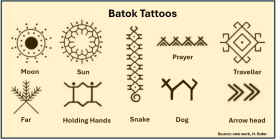Tattoos
Bacchus, the Latin form of Bakchos, a nickname of Dionysus, is the god of wine, joy, grapes, fertility, madness, and ecstasy in the Greek pantheon. The Greeks and Romans also called him Bromios ("noisy one"), Bacchus ("RUFER" in German"), or Bakchos because of the noise his followers made. So it was clear that "THE GOD "RUFER"" had to be on my back.
Tattoos in the Philippines have a long and rich history, deeply rooted in tribal culture. While traditional tattoos, known as "Batok," still play an important role in some communities, their social acceptance in modern Philippine society has declined. Today, tattoos can be viewed as a hindrance in some areas when seeking employment or entering educational institutions.
Traditional Filipino Tattoos (Batok):
Cultural Significance:
Batok tattoos are more than just body decoration; they are a symbol of identity, social belonging, personal achievements, and spiritual beliefs.
Technique:
Traditionally, batok tattoos are hammered into the skin using a thorn, usually from a grapefruit, and a piece of wood (a "drumstick"). The ink is obtained from a mixture of charcoal and water.
History and Meaning:
Batok tattoos have a long history and are deeply rooted in the culture and spirituality of the Filipino indigenous peoples.
- They served as a symbol of tribal affiliation, social status, bravery, and as a means of transmitting stories and symbols.
- The motifs were often geometric patterns, animals, plants, or abstract symbols, which varied depending on the tribe and individual.
- Traditionally, batok tattoos were worn by women and men alike and served as an expression of beauty, status, and spiritual connection.
- The placement of the tattoos also had significance and could indicate specific achievements or roles within the tribe.
Mambabatok:
Traditional tattoo artists, known as "Mambabatok," are often also healers, counselors, and storytellers within their communities.
Apo Whang-od:
One of the most famous Mambabatok is Apo Whang-od, a 107-year-old woman from the mountain village of Buscalan, who has achieved international fame through her traditional tattoos.





